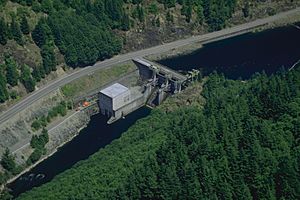Big Cliff Dam facts for kids
Quick facts for kids Big Cliff Dam |
|
|---|---|

Big Cliff Dam on the North Santiam River
|
|
|
Location of Big Cliff Dam in Oregon
|
|
| Country | United States |
| Location | Linn County–Marion County, Oregon |
| Coordinates | 44°45′3.6″N 122°16′59.16″W / 44.751000°N 122.2831000°W |
| Purpose | Power |
| Status | Operational |
| Construction began | 1949 |
| Opening date | 1953 |
| Owner(s) | U.S. Army Corps of Engineers |
| Dam and spillways | |
| Type of dam | Concrete gravity |
| Impounds | North Santiam River |
| Height | 191 ft (58 m) |
| Length | 280 ft (85 m) |
| Elevation at crest | 1,212 ft (369 m) |
| Reservoir | |
| Creates | Big Cliff Lake |
| Total capacity | 6,450 acre⋅ft (7,960,000 m3) |
| Surface area | 128 acres (0.52 km2) |
| Maximum length | 2.8 mi (4.5 km) |
| Power station | |
| Commission date | 1953 |
| Turbines | 1 x 18 MW Kaplan-type |
| Installed capacity | 18 MW |
Big Cliff Dam is a large concrete dam built across the North Santiam River in Oregon, USA. It sits right on the border between Linn County and Marion County, in the beautiful Oregon Cascade mountains.
This dam does many important jobs! It helps stop floods, makes electricity, provides water for farms (called irrigation), creates a good home for fish, keeps the water clean, and offers places for people to have fun. Big Cliff Dam is one of 13 dams built by the United States Army Corps of Engineers as part of a big plan called the Willamette Valley Project. This project was approved by the government way back in 1938 to help manage rivers.
Building Big Cliff Dam
Building Big Cliff Dam took about four years, from March 1949 to May 1953. It was built at the same time as another important dam nearby, called Detroit Dam.
Big Cliff Dam is located about 2.7 miles (4.3 km) downstream from Detroit Dam on the North Santiam River.
How the Dam Works
Big Cliff Dam has a special job: it helps to smooth out the river's flow. The Detroit Dam, located upstream, makes electricity, which can cause the river's water level to go up and down. Big Cliff Dam acts like a "re-regulator" to control these changes.
The water behind Big Cliff Dam forms a lake called Big Cliff Lake, also known as Big Cliff Reservoir. The depth of this lake can change a lot each day, sometimes by as much as 24 feet (7.3 meters)! This is because it's constantly adjusting the water flow from Detroit Dam.
Making Electricity
Big Cliff Dam can also make its own electricity. It has the power to generate up to 18 megawatts (MW) of electricity. This is enough power for many homes!
Helping Fish
The people who operate Big Cliff Dam work hard to protect the fish in the river. They try to keep the water temperature between 50 and 59 degrees Fahrenheit (10 to 15 degrees Celsius). This is the perfect temperature range for fish to live comfortably. They do this by carefully mixing water from the top and bottom of Detroit Lake, which is upstream from Big Cliff Dam.


